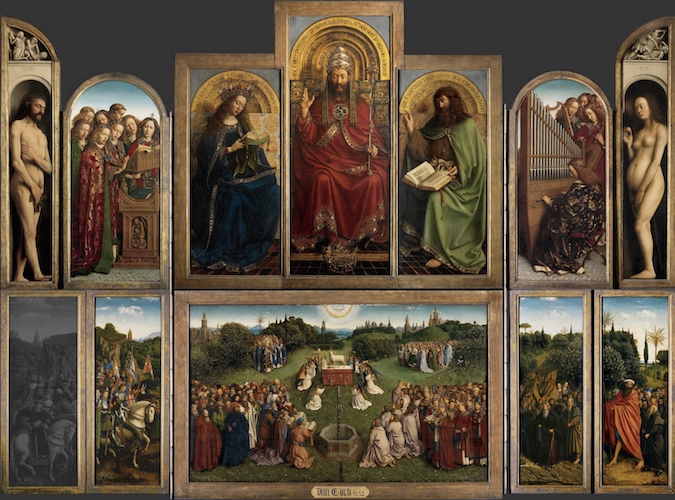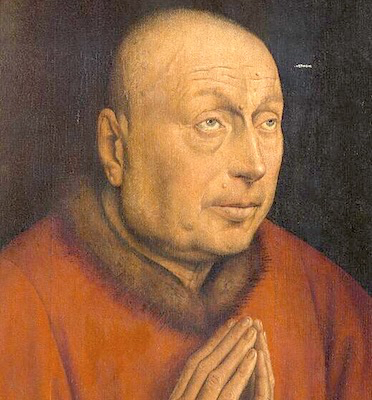As with all Art/Photography there is no point making it if no one can see it! So, who is this work aimed at and how would I approach marketing a work like this. Altarpieces originally were commissioned by a wealthy patron for the church - here is an example:
The ghent altarpiece has a rich history and it is amazing it has survived as it was; '
Removed from its place in the Cathedral of Ghent by Napoleon (well, the main panels, anyway) and then by German occupying forces during World War I, the panels were returned and reassembled, only to be taken again by the Nazis in 1942 and stored carelessly in a salt mine for the duration of the Second World War. The altarpiece was rescued by Allied art experts in 1945 (below) who reassembled, cleaned and restored the panels, which had lost much of their varnish and suffered some surface abrasion.' (Hickson S. Khan Academy: 2019). The piece itself was commissioned by a wealth patron by the name of Jodocus Vijd.
He commissioned it;
'Like most Renaissance patrons, Jodocus Vijd was a wealthy merchant who sought to expiate the sin of being too fond of money by spending some of it on creating a monument to God. An influential citizen of Ghent, Vijd commissioned the altarpiece for the Church dedicated to St. John the Baptist (now the Cathedral of St. Bavo) in his home city as a means of saving his soul while simultaneously celebrating his wealth.'(Hickson S. Khan Academy: 2019)
It is interesting that he thought that by creating this he would somehow get rid of his sin. Can spending money on something such as a sacred painting really absolve the sinner? However I will not start a debate here on sin but consider this is how these pieces were created and still today people commision works of art, some for their home, some for investment or for the community.
One piece of art that is very famous is
The Physical Impossibility of Death in the Mind of Someone Living by Damien Hirst (above). This was actually commissioned by Charles Saatchi the famous advertising magnate and art collector - he gave Hirst $50,000 to
“do whatever he wanted” (Comish Team: 13th April 2017). To bring this up to date - 'In 2006, the piece was sold for reportedly $8 million to investor Steven A. Cohen. However, since the piece was slowly decomposing due to improper preservation and according to Hirst, "no longer looked scary", the artist replaced the shark before Cohen took ownership of the piece.'(Comish Team: 13th April 2017).
So if it is commissioned obviously specifications for the piece usually come from the patron and the target market is the patron obviously as unhappy patron will not pay! However in the case of my own pieces I do not have a patron and the best way of getting this to an audience would be now to sell this online in an online gallery such as Saatchi Art and promote this on social media,many more people are buying art online and this is probably where the buyers are today. This article from Forbes
Art Market Cooling, But Online Sales Booming supports this and states that 'The art market is changing, and social media has become the primary way consumers discover art, according to a
study commissioned by Invaluable. The survey found that nearly a quarter (22.7%) of art buyers find new works of art via social media, which edged out museums (20%) and galleries (15.9%) as buyers’ primary source of discovery.' (Weinswig D. Forbes 13/05/16) Further to this the article stated that millennials are leading this market through art discovery on social media.
Therefore in real world terms I need to set up an online site to put this in the world - perhaps it will help me with my own sin....!
References
The Comish Team (17th April 2017)
7 of The Worlds Most Interesting Art Commissions [Online] Avaiable: https://www.comish.com/single-post/2017/04/11/The-7-most-fascinating-commissions (Accessed 12/02/19)
Dr Hickson S. (2019) Khan Academy,
Van Eyck, Ghent Altarpiece [Online] Available:https://www.khanacademy.org/humanities/renaissance-reformation/northern-renaissance1/burgundy-netherlands/a/vaneyck-ghentaltar (Accessed 12/02/19)
Weinswig D. (13/05/16) Forbes,
Art Market Cooling but Online Sales Booming [Online] Availble: https://www.forbes.com/sites/deborahweinswig/2016/05/13/art-market-cooling-but-online-sales-booming/#e0625856ec9a (Accessed 12/02/19)


































